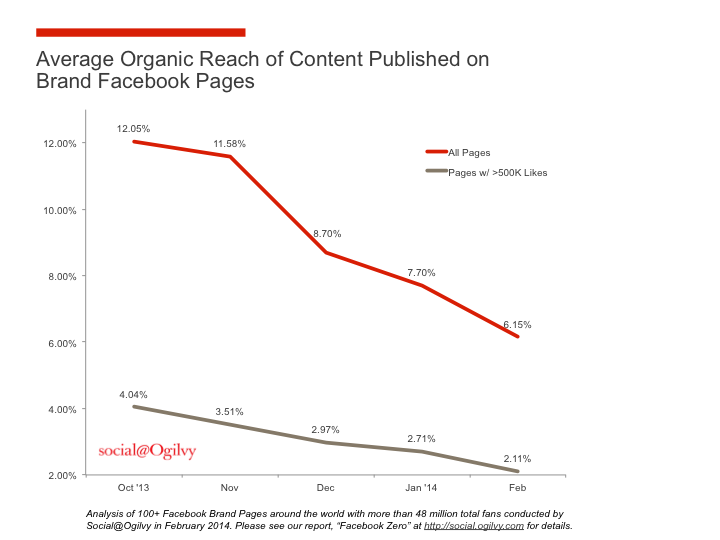If you haven’t noticed already, Facebook organic reach is practically nonexistent. Dead? No, let’s not go that far. However, since 2012 there has been a steady decrease in organic reach. The graph below clearly shows the decline, and this isn’t even including numbers from 2015!
Yes, these are averages and there is an argument to be made by some companies who may not fit into this ~6% reach range. Depending on the amount of fans you have and the type of content you’re sharing, your reach can vary. Some companies may not have seen this steep of a decline in reach, while others may only be reaching about 2% of their fans.
Do Your Research & Step Up Your Organic Game
So how do you combat this decline? It’s a question a lot of marketers have. Organically speaking, the only thing you can do is test different posting strategies. For example:
- Posting on different days / times to find out which is best (but that’s constantly changing).
- Testing which types of posts get the most engagement: photos, links, videos or text.
- Make sure the content you’re sharing is actually relevant to your fan base.
- Staying away from sales-y posts that will be restricted by Facebook. (Not sure what I mean by this? Read more about it here: http://www.wsj.com/articles/new-facebook-rules-will-sting-entrepreneurs-1417133694
After some extensive research organically, you may still be disappointed in your reach and engagement. Don’t take it personally; this is typical for a majority of businesses. The #1 way to combat this decrease is by paying.
Open Your Mind…and Your Wallet
Facebook, like almost all other social networks, has integrated ads and “sponsored” posts into its platform. If you’re hesitant about investing any time or money in to Facebook ads, let me first clear up some common misconceptions:
- There is no point in spending money; only a few more of your fans can see the ad.
- Wrong. Facebook has some of the most (if not, the most) sophisticated targeting that advertisers can use to reach new or current customers. For example: You have the ability to target new moms, between ages 22-35, who own a Subaru, and live in a 20-mile radius of your store. The possibilities are limitless. But if remarketing is what you want, you can upload customer lists or target people who have visited your site.
- I don’t have another $5,000 to invest in digital advertising like I do with AdWords.
- Not a problem. Although a big budget never hurt anyone, Facebook ads have been successful running at just $500 a month.
- I’m trying to boost traffic to my website, not my Facebook page.
- Do both! There are 10+ ad formats to choose from. For instance it ranges from “Page Likes” that help increase your Facebook page fan base, to “Website Clicks” which drives traffic to the web page of your choice, or even “Offer Claims” which serves your target audience a coupon for them to directly download.
- No one clicks on them.
- Not true. Facebook ads perform much like any other platforms display or search ads. I cannot give you specific numbers since there are too many variables, but use this graph as a very general idea of Facebook ad performance. (http://www.salesforcemarketingcloud.com/wp-content/uploads/2013/06/The-Facebook-Ads-Benchmark-Report.pdf)
- Even if it is cheap and people are clicking, you can’t track anything.
- Very wrong. Facebook has in depth reports that you can pull monthly or even daily. Also with the new “pixels” that can now be added to your website you can start tracking conversions or create custom audience lists.
Now that I’ve cleared all of that up, what’s stopping you? Implementing an engaging organic posting strategy can help, and should already be in place, but it may not help increase your visibility. So take Facebook ads for a spin and watch how it helps increase your reach, engagement, and even sales (gasp.)